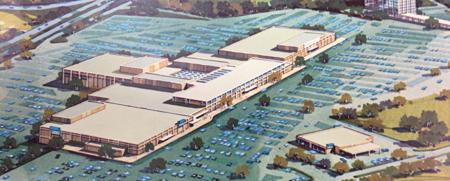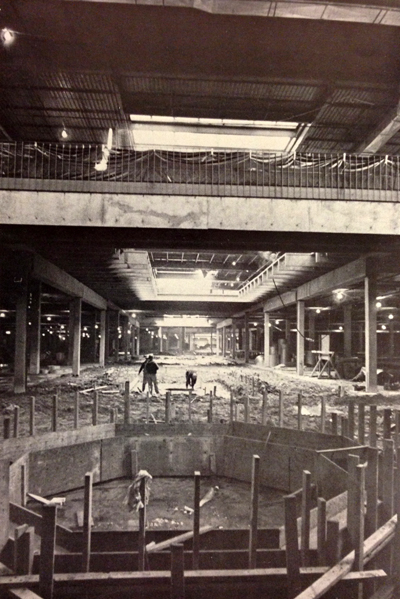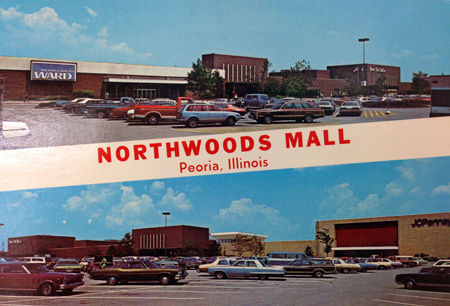
It opened on August 16, 1973 — 40 years ago next month.
Northwoods Mall was Peoria’s first indoor shopping center, and it was a long time in the making. It was conceived by Carson, Pirie, Scott, & Co., longtime downtown department store anchor and successor to Block & Kuhl. In 1961, they acquired the land bounded by I-74, US-150 (War Memorial Dr.), and Sterling Avenue. Back then, this was the very northwest edge of town. There was no Westlake Shopping Center (that would come shortly after Northwoods was built), let alone Glen Hollow. The land and roads were rural.
Soon, Carson’s partnered with two other downtown stores to become equal partners in the venture: Montgomery Ward and JC Penney. In 1965, a coalition of downtown merchants and some merchants from Sheridan Village raised objections to the rezoning and filed suit against Carson’s. By 1970, the lawsuits were settled out of court, and in February 1970, the Peoria City Council gave final zoning approval.

The mall was designed by Chicago architects Sidney H. Morris & Associates. Original tenants (in addition to the three anchors) included Seno & Sons Formal Wear, Campus Music Shop, Moore Jewelry, Stride Rite Shoes, Susies Casual, Baker Shoes, Jeans West, B. Dalton Book Sellers, Kay Howard Shop, Petrie Stores, Brooks, Byerly Music, Browns Spoting Goods, O’Connell’s Restaurants, Kinney Shoes, Thom McAn, Foxmoor Casuals, Konee’s Restaurant, Fannie May, Tie Hut, Fact Foto, Florsheim, Aladdin’s Castle amusement center, Musicland, Evenson’s Card Shop, Just Pants, Claire’s Boutique, Dutch Mill, Burton’s Shoes, Fab-N-Trim, Page Jewelry, Honey Bear Farm cheese and gourmet food store, Gallenkamp shoes, National Shirt Shops, Paul Harris Stores, Helzberg Jewelers, Orange Bowl fast food store, Regal, General Nutrition, Singer, and Savings Center Enterprises (development corporation owned by First Federal Savings & Loan Assoc.). [See complete list of tenants c. 1984 by clicking here]
The mall was managed by Harold Carlson Associates of Chicago from its opening in 1973 until November 1983. In May 1983, Carson’s sold its one-third share in the mall to Cleveland’s Jacobs-Visconsi-Jacobs mall management firm, and in October, Wards sold their share to Melvin Simon and Associates (now Simon Property Group) of Indianapolis. Simon was chosen to manage the mall in November 1983, and it now fully owns and manages Northwoods. The change in management wasn’t without its critics. Several store owners at the time told the newspaper that Simon was more interested in getting national chains than supporting local stores. Simon countered that they felt they were providing the right mix of chain and local shops to serve the needs of the community.

Perhaps the most famous tenant of Northwoods Mall was the Skewer Inn. In October 1983, 28 people who dined at the Skewer Inn contracted botulism from tainted onions served sauteed on patty melt sandwiches. The sickened restaurant guests survived (well, one person died months later, possibly in part due to complications from the illness), but the restaurant didn’t. Although they tried to reopen, they never could rescue their reputation.
One restaurant that didn’t make lists of tenants was The Nordic House. It was located inside Carson’s on the lower level and had a Scandinavian theme. According to the newspaper, the restaurant “face[d] an outside garden area on two sides, with sculpture and plantings enclosed by a wall attractively blended into the architecture of the building. The restaurant will offer buffet and waitress service for lunch Monday thru Saturday, dinner Monday thru Friday, and will be open for buffet service only on Sunday.” It received good reviews for food and service in later newspaper accounts.
It didn’t take long for Northwoods’ impact to be felt downtown. Just a year after it opened, a study was released that showed sales were down in the old central business district. Downtown retailers tried to stay positive, but within a decade, most of them had closed their downtown stores and either moved to the suburbs (“if you can’t beat ’em, join ’em”) or disappeared for good. Today, the central business district is predominantly parking, offices, and civic buildings.
I called Northwoods to see if they have any plans for a fortieth anniversary celebration. They said their plans were not finalized and they were not ready to announce anything at this time, but they’d let me know. If I find out anything, I’ll post the update here.
Share your memories of Northwoods in the comments section below.

